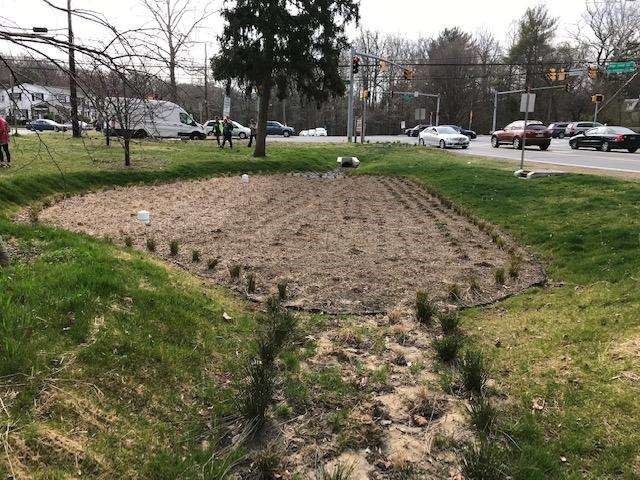Partnerships Making a Difference in Sligo Creek
In the past, civil engineers used to address drainage issues by designing stormwater drainage systems that quickly flushed stormwater into streams like Sligo Creek. These old methods unfortunately caused significant environmental damage by eroding the streambanks, exposing previously-buried sewer pipes (leading to sewer leaks in the stream), and killing aquatic creatures from the fast-moving water, increased salination in the Spring, and increased water temperatures during Summer. Today, professionals with various backgrounds are working together to address our stormwater drainage along Sligo Creek in smarter and more environmentally sensitive ways.
On our Stormwater Tour along Sligo Creek Parkway between Colesville Road and the Beltway on March 30, 2019, we were shown many examples of how Montgomery Parks staff have worked together, and have sometimes worked with outside agencies, such as Washington Suburban Sanitary Commission (WSSC) and the Montgomery County Department of Transportation (DOT) professionals, to design stormwater management solutions that have enhanced Sligo Creek Park.
A map of our tour can be found here.
Site 1: Bio-Retention System at Corner of St. Andrews Way & Colesville Road and Sligo Creek Parkway
The first stop on our tour was at the bioretention system at the corner of Colesville Road and Sligo Creek Parkway. The bioretention system collects stormwater runoff from a 4-acre drainage area. While the bioretention system looked dormant, soon nine species of plants will fill the mulched area. The mulch and soil root zone help absorb stormwater runoff and, using a process called phytoremediation, break down pollutants such as oil on roadways. The stormwater runoff collected from the surrounding roads and other hard surfaces when it rains percolates through the special bioretention soil. Once the runoff is cleansed and cooled, it is collected in perforated pipes deep within the soil and piped to Sligo Creek. The street corner, once an eyesore, will soon be a source of beauty and color when the garden plants emerge. This project was made possible by Parks engineers working with the DOT, Parks biologists, and the plant growers at Pope Farm (the Parks nursery for plant materials).
Site 2: V-Formation at Stream Stabilization Project
A short way upstream Sligo Creek, we were shown a cross vane stone structure with stone drops which channels creek water flow into the center of the creek. The stone V-formation directs the water to the center of the stream, protecting the stream banks from erosion, and the mini-waterfalls help improve water quality by increasing the oxygen content of the water. Working closely with biologists, the engineering staff carefully designed the stone structures to prevent fish blockages. The project was initiated to repair a leaking WSSC sanitary sewer as part of the WSSC Consent Decree. By using stones strategically to protect the sewer line by stabilizing the streambed, Parks staff was able to provide new habitat for creek critters.
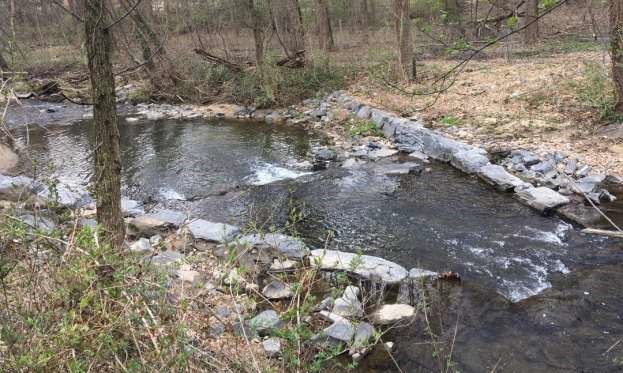
Site 3: Parkside Wetlands Restoration
We next visited a wetlands restoration site by Parkside. Because of the high ground water levels, Parks staff decided not to use techniques that encourage the infiltration of stormwater into the ground. Instead, logs and stone aprons were used to spread out the water in deep and shallow areas, and wetland plants were planted throughout the zone to create a healthy, complex ecosystem. Because it was still March, we were not able to see the vegetation, but soon the site will be full of wetland plants. When asked about mosquitoes, Parks Natural Resource Specialist Matt Harper noted that a healthy wetland habitat will host many mosquito predators. The steady flow of water through the wetland will also discourage mosquitoes, as mosquitoes prefer standing water. The design team included a tree expert who worked to ensure that nearby tree roots were not damaged during the installation work. Parks staff are monitoring how well the wetland is functioning.
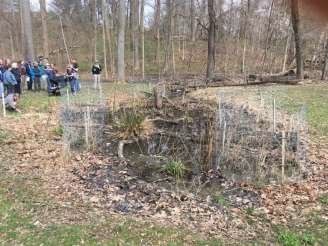
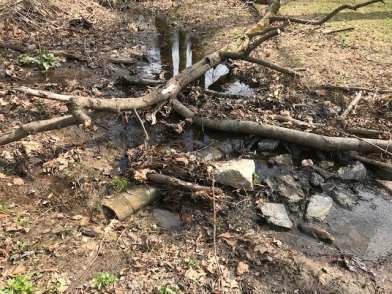
Site 4: Bioretention System by Park Headquarters (see the Before & After Photos)
The next stop was another bioretention system. At this stop we learned about the Parks staff of Pope Farm who are part of the team of professionals working on these projects. The Pope Farm staff work to provide plants that are the proper ecotype, which are plants carefully propagated from local sources, not just the correct species. Considering the plant’s ecotype rather than just the plant species has resulted in creating habitat that provides maximum ecological benefits.
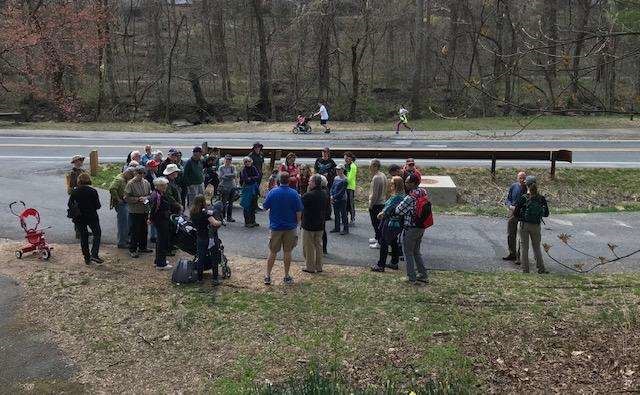
Site 5: Bridge scheduled to be Replaced by Edgevale Tributary
The next stop was the bridge over Sligo Creek near Brunett Ave. In June 2019, replacement of the bridge will begin, removing paving along Sligo Creek, restoration work along Sligo Creek, and addressing an exposed sanitary line and damaged stormwater outfall along what the staff referred to as the Edgevale Tributary. Parks staff plan on “raising” the Edgevale tributary to reconnect the tributary stream to the floodplain.
This project will help restore the hydrology along Sligo Creek. By raising the Edgevale Tributary streambed, water will flow into the surrounding wetland soil instead of draining into the tributary as it has been doing because the streambed has been eroded. This erosion was due to excessive waterflow from extensive hard surfaces in the neighborhood during rain events.
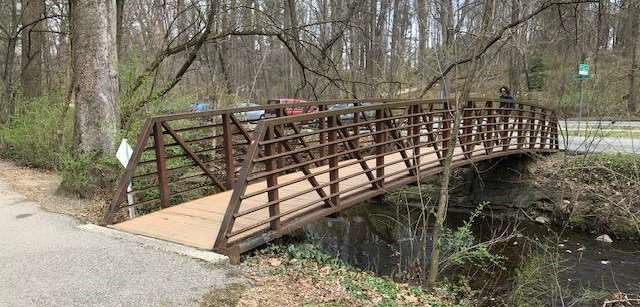
Site 6: Crosby Road Restored Wetland Site
The next stop was a restored wetland near Crosby Road. Not too long ago the restoration site was a monoculture of grass which was mowed with great difficulty, and mosquitoes were a problem since the area was a wetland without mosquito predators. By creating a complex healthy ecosystem with habitat including logs and plantings to support other wildlife, mosquitoes have been reduced. The area once hosted many Ash trees but the Emerald Ash borer is an exotic pest that has devastated ash trees in the area. These Ash trees were cut down and their logs were repurposed as habitat for the restoration project.
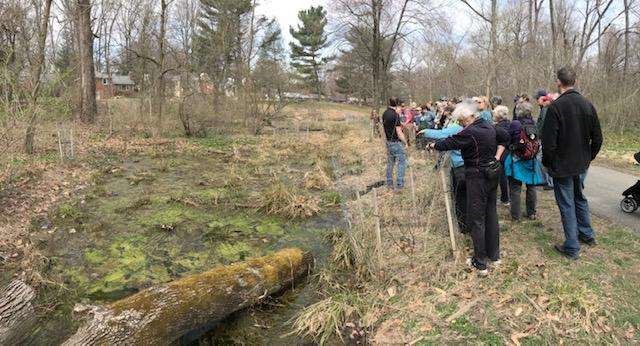
Site 7: Bioretention System at Sligo Golf Course (see Before & After photos)
The last stop was one of the bioretention systems in front of the Sligo Creek Golf Course. Parks staff noted that in May the dormant gardens will be filled out with beautiful blooming flowers. Parks worked with the golf course to install stormwater facilities along the golf course property. Trees have also been planted. Additional projects are planned for the large asphalt parking lot.
By piggybacking off projects already in the pipeline, Parks staff have greatly sped up the time it takes to get a project in the ground and protect Sligo Creek. The next phase will include focusing on Sligo Creek Park from Colesville Road to Wayne Ave. The Parks staff stressed that they need our help. While Parks staff have worked diligently to improve Sligo Creek, they cannot do this alone. They need homeowners along Sligo Creek to slow down and manage stormwater on their properties, and they need our help in educating our neighbors on our role in improving the creek.
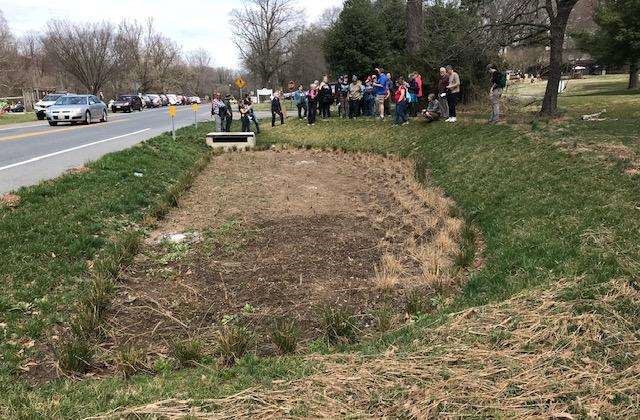
You can learn more about the Montgomery Parks Environmental Restoration and Stormwater Outfall Infrastructure Rehabilitation Program website.
And you can see more pictures taken during the tour on the FOSC Flickr page.



